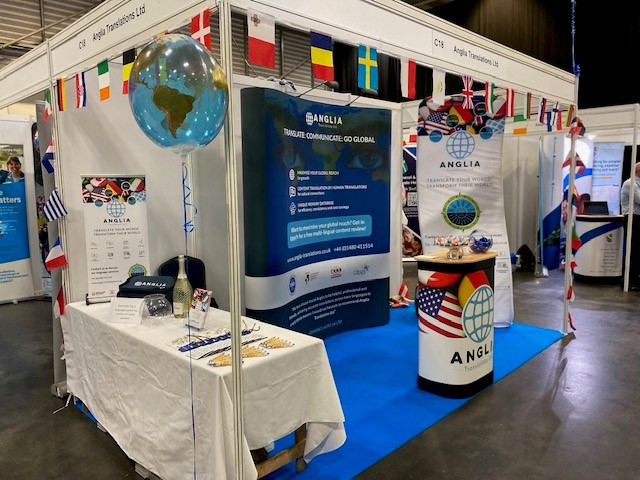Anglia Translations Ltd Founder Publishes First Book
Anthony Withers, founder/director of Anglia Translations Ltd has just published his first book: Great Staughton and its People: How a Huntingdonshire Village made its Mark on England’s History.
In this piece, we will explore the background of Anthony’s recently published work and speak to the author himself to gain an understanding of both the book and the man behind it.
Who is Anthony Withers?
Anthony Withers was born in Prestwich, Manchester in 1945 and received his education at Stand Grammar School and Queen Mary University of London where he studied Modern Languages.
After many years working in export sales throughout Europe and then teaching business French to local businesses in Cambridgeshire, he founded Anglia Translations Ltd in Huntingdon, to meet the growing demand in the UK for quality translation services following the signing of the Maastricht Treaty.
Anthony has lived in Great Staughton for over 45 years, has a son and daughter (the current Managing Director of Anglia Translations Ltd), and five grandchildren.
What is the Book About?

Great Staughton and its People profiles the extraordinary history of a seemingly modest Huntingdonshire village which, over the past 2,000 years has played host to some remarkable characters and events of national prominence.
Oliver Cromwell, the famed politician and military leader, for instance, was born just ten miles down the road in Huntingdon. Catherine of Aragon, the first wife of Henry VIII, was imprisoned in the castle in nearby Kimbolton.
The book offers incredibly detailed biographies of these historical figures and many more; setting their life and work into a wider context of English history from Roman times to the present day.
An Interview with the Author
Anglia Translations Ltd: The first question is about Great Staughton. Where is it and what’s special about it?
Anthony Withers: Great Staughton is in the south west of the old county of Huntingdonshire, 10 miles south west of Huntingdon and 20 miles west of Cambridge.
Huntingdon was the birthplace of Oliver Cromwell, who set off the first revolution in Europe. Catherine of Aragon was imprisoned in the castle in nearby Kimbolton so there is already plenty of history in the area.
ATL: What inspired you to write the book?
AW: The first thing I noticed when I moved into the village 40 odd years ago was the sundial in the Highway, the main thoroughfare of the village.
It is inscribed: 1637: E.I.
Nobody knew what this meant, and even the County History couldn’t tell me. I found the answer thanks to the Huntingdon Records Office. E. I. turned out to be Edmund Ibbutt, an important landowner in the 1630s and 1640s.
That started me off on a historical quest, so my next step was to take a look at the monuments in the historic village church of St Andrew. Amongst the many memorials and brass plaques is a wonderful double monument to Sir James Dyer. Who is he? I thought.
George Wauton has a splendid tomb here. What did he do? So I started to do a little research on these two figures.
ATL: And what did you discover?
AW: Well, James Dyer was the lawyer who introduced the concept of legal precedents into English Common Law in the sixteenth century. It still stands today.
George Wauton had an illustrious career which included marching 200 men to Tilbury to fight off the Armada.
ATL: How did you combine research with running a company?
AW: Badly, to be frank. Research is also a full-time job. It’s not possible for ordinary mortals like me to combine extensive research with the day to day running of a busy company.
I wasn’t able to truly focus on my research and writing until after my retirement.
I note that Lord Jonathan Sumption has just completed, after forty years of work, the fifth and final volume of his History of the Hundred Years War whilst presiding over the Supreme Court. I’m afraid I don’t have his talent!
ATL: So where did these preliminary researches take you?
AW: After Dyer and Wauton, I dug a little deeper, with the help of the Records Office, and discovered an incredible array of people from this little village who had taken part in some of the great events of England’s history.
ATL: Can you give us some examples?
AW: There are many. We can start with the unnamed Roman official who built a splendid villa here 2,000 years ago. Why? What was the purpose of the villa? The book offers an explanation.
Then there is one of my favourite characters: Fanny Duberly. This eminently respectable country lady decided to accompany her husband to the Crimea where she wrote a devastating journal describing the horrors of that campaign.
She even witnessed the Charge of the Light Brigade. Her Journal and the letters she wrote to the press make her one of the real heroines of the Crimea – up there with Florence Nightingale and Mary Seacole, in my view.
ATL: You mentioned Oliver Cromwell. How did the Civil Wars affect Great Staughton?
AW: Well, firstly, Valentine Walton was born in the village. His name may not be immediately familiar, but he was the brother-in-law of Cromwell and was dedicated to the Parliamentary cause. He was also one of the killers of the king, having signed the death warrant of Charles I. The book traces his life story.
Secondly, Walton’s contemporary was John Gaule, vicar of St Andrew’s and his claim to fame is that he delivered a series of sermons from his pulpit which effectively destroyed the reputation of the Witch Finder General himself, Matthew Hopkins.
ATL: There’s a chapter in the book about Richard Walter and his adventures on the high seas with Captain Anson.
AW: Richard Walter’s account of his Voyage round the World with Captain Anson is a terrific adventure story of storms, mountainous seas, devastating disease, mutiny, murder and shipwreck as Anson sets off to capture the Spanish treasure galleons plying between Peru and China.
Reading this account you can see where people like Patrick O’Brian drew their inspiration.
ATL: And there’s a connection with the Romney Hythe and Dymchurch Railway?
AW: John Howey, who founded the RH&D railway, built a 15” gauge model railway in the grounds of Staughton Manor, which provided the inspiration for his great project.
ATL: That’s quite a list of people from one little village?
AW: And there are many more! The first documentary evidence for the village is a very rare Anglo-Saxon will, dated 989, of a nobleman called Ælfhelm Polga. Delving into ancient documents revealed his life and times. 200 years later, the book traces the career of a knight of Edward I who met a violent end in Gascony.
One of the most intriguing chapters in the book is a 200-year-old literary mystery, a 600 page book that came to light 50 years ago. Written in an elegant hand it contains poems, anecdotes, moral stories and scientific reports. Who wrote it and why? The book unravels this historic detective story.
ATL: Why did you self-publish the book?
AW: Publishers tend to be wary of books on local history by an unknown and untested author, so I did it myself.
ATL: How did that work?
AW: I found a marvellous expert who took the manuscript and turned it into a proper book. An expert created the cover and eventually I held in my hands the finished work.
ATL: You’ve recently launched the book. How did that go?
AW: I launched the book on September 9 in our local pub, the White Hart. I’m pleased to say it went well and people were very complimentary. I think many were surprised that our village seemed to have produced more than its fair share of notable people over its 2,000 year history.
ATL: A best seller in the offing perhaps?
AW: I hope the book will do reasonably well. It’s a collection of great adventure stories of English history, but I doubt it will outsell Master Potter.
You can find out more about the book on the Great Staughton Parish Council website, and the book is now available to purchase on Amazon at £25 (hardback) and £18 (paperback).
If you’d like to learn more about anything we’ve covered in today’s blog, or you’d like to speak to usin regards to any of our services, why not get in touch?



